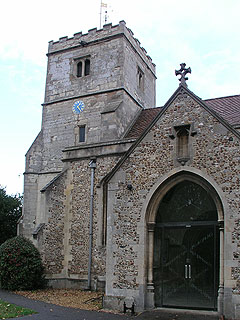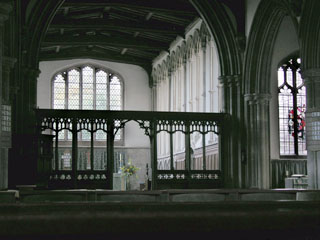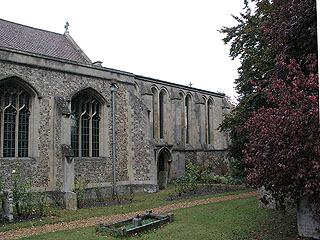Cherry Hinton is part of the Cambridge conurbation, but maintains its independence rather better than some of the other villages that have been swallowed up. I'm thinking particularly of Chesterton, now just a northern suburb; but even places like Fulbourn and Girton can occasionally seem like little more than dormitory settlements. Not so with Cherry Hinton. It even has a level crossing, to reinforce the 'This is a proper village, got that?' message.
It also has a much nicer church than most of the other Cambridge satellite villages. St Andrew's is set a little way north of the level crossing, in a spacious churchyard filled with beautiful trees. Not that we paid it much attention when we arrived; despite the sun having been bright when we left the centre of town, by the time we arrived it was ominously grey, and the first rain caught us just as we ran into the porch. On leaving, though, we had the time to admire the exterior. The churchyard is lovely - full of bright autumnal colours from the beech and cherry trees when we were there in late October 2003 - and (if we ignore the horrid parish room hidden away on the north side) the exterior is fine too. I was very struck with the tower, which is built entirely of stone and looks very squat and square. The stair turret is inside, so the outline is unusually regular. The other thing that catches the eye from the outside is the extraordinary chancel. But more of that anon.
The oldest part of the church is the base of the tower - from the outside it looks like a standard late-medieval affair, but the jambs of the tower arch reveal it to be at least partially transitional. In the space underneath sits the Norman font, and also, built into the west wall, a coffin-shaped grave slab. At the top are carved the head and shoulders of a man, his features almost obliterated by the passage of time. The quality of the carving was obviously rustic to start with, and there is now something powerful and primitive about him - a dark counterpoint to the elegance and light of the chancel.
The nave is really quite dark. This is partially because it is a big space, and lacks a clerestory - there was a 15th century on, but it collapsed. By the 1870s the nave was in a bad enough state that Gilbert Scott had practically to rebuild it. The horrid stacking chairs spoil the space a bit, much as the guide says that the lack of pews allows us to appreciate the grace of the 13th century arcades. A few of the medieval bench ends do survive, however. They are attached to foreshortened benches up against the north aisle wall; the poppyheads are pockmarked and mutilated but still lovely. My favourite was one with angels dressed in scale mail and smiling serenely in both directions. The full set of benches survived at least as late as 1774 - only ninety years before Gilbert Scott launched his rescue efforts. Other major pieces of furniture were also lost - although Gilbert Scott himself was the culprit in the case of the Jacobean pulpit (in the event it ended up nearby at Teversham). Mysteriously, he also removed the 15th century chancel screen, despite admiring its 'flying buttresses' and paintings of saints. It was later put back into place, but the pictures of saints have gone. Some original paint remains on other bits of the woodwork, but it's a sad battered old thing.
Beyond the screen, we find a great Early English temple to light and proportion. The chancel of St Andrews is a glorious thing; a remarkable survival given the neglect that the church suffered for hundreds of years. Tall thin windows in pairs alternate with blank arcades (corresponding to buttresses on the outside); they are separated by slender shafts connected to the wall only by a few shaft-rings. Over the tops of the windows these shafts split into cinquefoil arches of parallel moulding. The proportions are wonderful - it is a big chancel, and the slender soaring verticals make it feel even bigger than it is. It is a beautiful composition, even having lost the original east window (it was replaced in the 16th century). The double piscina and triple sedilia are also very richly ornamented. It is quite the loveliest piece of 13th century work in Cambridgeshire, and the guide boasts that it has few rivals in the country. I can well believe it. [Mark adds: It is indeed lovely, and reminds me of the great Refectory at Mont St Michel, which has exactly the same effect of light streaming in through multiple narrow windows - almost like walls of light]
St Andrew's was open when we visited.


